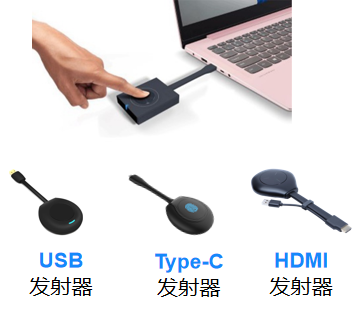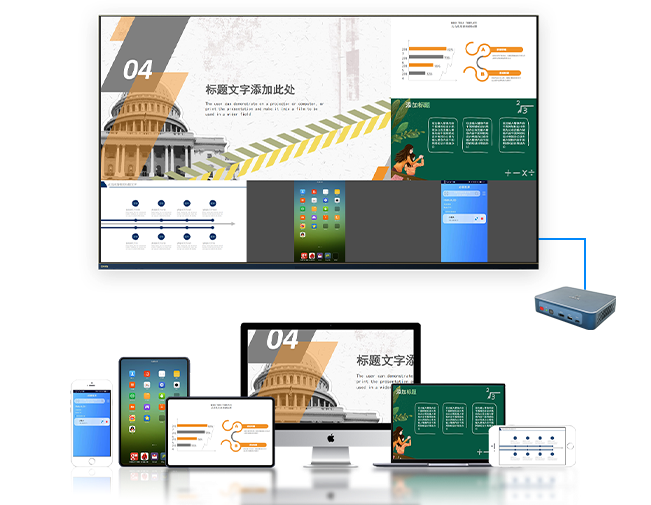What are the functions of Bijie Multimedia Collaboration System? How to use it?
The Bijie Multimedia Collaboration System has many functions, not only screen casting, but also practical functions such as information publishing, screen casting watermark, weak network confrontation, multi-channel screen casting, interactive control, and bidirectional reverse control. The specific functions are as follows:
- Airplay screen mirroring: supports Apple iOS The built-in Airplay projection function of MacOS devices does not require the installation of any software; Support Airplay multi channel projection;
- ★ Miracast screen mirroring: supports Android devices (mobile phones The built-in wireless screen projection function of the Pad system does not require the installation of any software; Support miracast multi-channel projection; Supports HDCP and can play copyrighted content information normally;
- ★ WiDi screen mirroring: supports the built-in wireless screen mirroring function of Windows 8/10/11 computers, without the need for any software installation;
- ★ GooGlecast screen mirroring: Supports wireless screen mirroring on Android devices with Googlecast, supports Chrome Edge browser screen mirroring;
- ★ Huawei Cast+screen mirroring: supports the wireless screen mirroring function provided by Huawei/Honor phones (including HarmonyOS), without the need to install any software;

- Client screen mirroring: can provide Android IOS, MacOS, and Windows 4 sets of transmitting software, supporting Windows Install software client for wireless screen mirroring on Mac, Android, and iOS devices; Support scanning screen casting and screen casting code screen casting; The PC client supports extended screen mirroring and program window mirroring; Client screen mirroring supports cross network segment mirroring;
- Button transmitter: Optional button transmitters with USB/HDMI/Type-C interfaces, supporting one click screen projection;

- ★ AOA cable screen mirroring: Supports Android device USB cable screen mirroring;
- ★ Screen casting PIN code: Supports screen casting security encryption, compatible with Miracast PIN code, which can effectively avoid accidental casting;
- Projection distance: There is no distance limit for LAN projection; Point to point projection (unobstructed) can reach a maximum of 40m;
- ★ Screen casting watermark: supports displaying the watermark information of the screen casting environment (device name, current conference room, time, etc.) on the screen casting screen, facilitating information tracing;
- ★ Snatching mode: Provides the function of opening and closing the scrambling mode, allowing or prohibiting the next user’s screen mirroring screen from occupying the current display screen;
- ★ Reverse screen control: Supports USB Touch, supports reverse screen control for Android phones and Windows/Mac computers;
- ★ BYOM Wireless Meeting: Supports BYOM function, equipped with a wireless meeting companion that can wirelessly connect computers to conference room AV devices (USB cameras, microphones, speakers, etc.), supports Teams Zoom、 Video conferencing platforms such as Tencent Meeting, DingTalk, and Huichang; (Optional, this function needs to be used with wireless conference partners)

- Voice subtitles: supports real-time conversion of voice into subtitle information, and supports saving and exporting. (To be used with Sibichi microphone)
- Multi screen display: It can support up to 9 wireless projection terminals for simultaneous display, and can adaptively switch between 1, 2, 3, 4, and 6 multi window displays on the display terminal. In a multi screen layout, it supports mute, full screen, or move out operations for a single display screen;

- Group discussion: Ensure that multiple intelligent interactive devices can achieve screen interactive broadcasting between group screen devices and main screen devices within the same LAN. The main screen can broadcast to each group, display multiple group screens for comparative teaching, and broadcast designated group screens to other group screens;
- Weak network transmission: supports weak network transmission countermeasures, and can still smoothly and stably screen cast even in a network loss rate of 10% to 20%;
- Electronic Whiteboard: With built-in electronic whiteboard function, it can write smoothly and supports functions such as colorful brushes, screen clearing, content circle drawing, writing movement, content copying, file saving, background changing, image insertion, QR code sharing, etc;
- Annotation function: supports annotations on the current screen, provides colorful brush annotations, supports annotation saving, QR code scanning, browsing, and saving functions.
- OPS linkage display: Connect the Type-C interface of the smart box directly to the USB interface of the OPS host, achieving wireless screen projection and direct display and functional control on the OPS Windows interface without switching the HDMI signal source;
- Web Wallpaper: Supports setting web pages as startup wallpapers, and web pages support online operations;
- Information publishing: With built-in image, video, and subtitle push functions, the content and publishing of information can be customized and set through a web management system or unified management platform;
- USB browsing: supports USB browsing function, supports browsing and playing files such as images, videos, and documents;
- Linkage on/off: Supports synchronous on/off of smart boxes and display devices. The smart box micro USB interface is directly connected to the display device USB, and the smart box automatically performs on/off processing by detecting whether the display device USB has current and judging the on/off status of the display device.
- Independent signal source access: supports third-party HDMI independent signal source access function, can set HDMI access display optimization or wireless screen projection display priority, achieve logic display customization settings for wired and wireless screen projection;
- RTSP streaming: supports RTSP streaming services and can connect to recording and playback servers;
- Screen casting status monitoring: supports display of screen casting resolution, packet loss rate, bit rate, frame rate, and signal strength information;
- Web management: Intelligent terminals support web management and control, allowing remote device parameter configuration and product operation and maintenance through web management;
- Automatic On/Off: Equipped with an independent MCU processing circuit, it can monitor the status of the host, support timed on/off, delayed on/off, and timed restart functions;
- Web authentication: supports Portal login authentication, providing more secure network connection services;
- Centralized management: can access the unified management platform, support remote control, and support unified operation and maintenance control;
- Central control API: It can provide control API interfaces and integrate and dock with external IoT devices such as central control and smart podiums;
The above are the general functions of the Bijie Multimedia Collaboration System. If you want to learn more information, you can contact us!